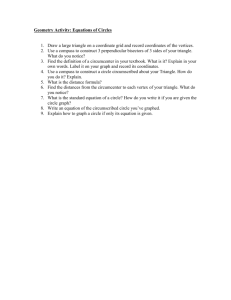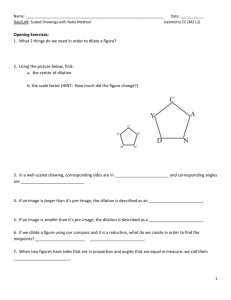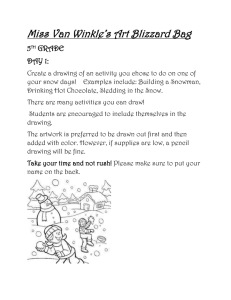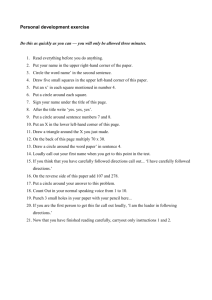Basic Drafting and Lettering
advertisement
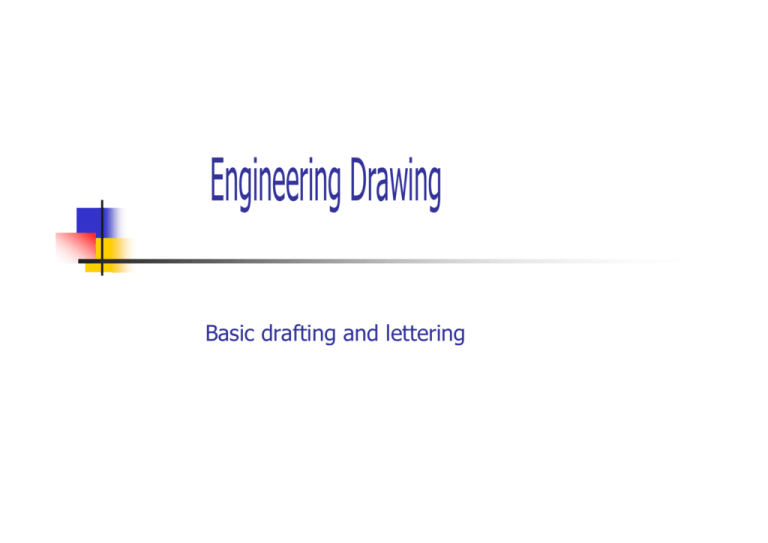
Engineering Drawing Basic drafting and lettering Lettering, Sketching and Line Techniques A engineering drawing is a highly stylized graphic representation of an idea. The idea might be of something that we can see such a real or virtual object, space or environment. In some cases, such as an electronic schematic diagram for example, the drawing will bear no visual resemblance to the physical object that will be built from the information it provides. In every case with the possible exception of "3D" and rendered drawings, which communicate with a different graphics language, we can understand engineering drawings only because we can understand the basic language of technical graphics. Attachment of paper to the board The sheet should be placed close to the left edge of the drafting board. Working in this area makes the T square easier to handle and reduces the likelihood of error because of T square “swing.” The drafting sheet should be far enough from the bottom of the board about 100 mm. to ensure firm support for the head of the T square when you are drawing at the lower part of the sheet. After aligning the drawing sheet, smooth out any wrinkles and fasten the four corners with short strips of drafting tape. If you are attaching large sheets, you should place additional strips of tape at the top and bottom edges of the sheet. Avoid the use of thumbtacks; they will eventually ruin the drafting board Horizontal Lines The draftsman’s horizontal line is constructed by drawing from left to right along the working edge of a T square. This working edge, when true, is perpendicular to the working edge of the drafting board. Horizontal Lines When you draw horizontal lines, keep the working edge of the T square head in firm contact with the working edge of the drafting board. The pencil should be inclined to the right at an angle of about 60 degrees, with the point close to the junction of the working edge and the paper. Horizontal Lines Hold the pencil lightly and, if it was sharpened with a conical point, rotate it slowly while drawing the line to achieve a uniform line width and preserve the shape of the point. Normally, when a series of horizontal lines is being drawn, the sequence of drawing is from the top down Vertical Lines Vertical lines are produced parallel to the working edge of the drafting board by using triangles in combination with a T square. Vertical Lines One leg of a triangle is placed against the working edge of the blade and the other faces the working edge of the board to prevent the draftsman from casting a shadow over his work. Vertical Lines Lines are drawn from the bottom up. The pencil is inclined toward the top of the working sheet at an angle of approximately 60 degrees, with the point as close as possible to the junction of the triangle and the drafting paper. Vertical Lines Sequence in drawing a series of vertical lines is from left to right. At no time should the lower edge of the T square blade be used as a base for triangles Inclined Lines Inclined lines at standard angles are constructed with the T square as a base for triangles used either singly, as shown or in combination. Used in combination with the T square as a base, the triangles serve as guides for producing lines at intervals of 15 degrees. Used singly, the 45-degree triangle will divide a circle into 8 equal parts; the 30°/60° triangle will divide a circle into 12 equal parts. For drawing lines at angles other than those, you should use a protractor. It is understood that the triangles in each case are resting on the blade of the T-Square Inclined Lines It is possible to divide 360 degrees angle into twenty-four 15 degrees sectors with the triangles used singly or in combination. Protraction of Angles To measure an angle, place the center mark of the protractor at the vertex of the angle, with the 0-degree line along one side. Then note the degree mark that falls on the side. To lay off an angle, position the protractor as above and use a needlepoint or a sharp-pointed pencil to mark the desired values. Then project lines from the vertex to these marks. Using only the three points on the protractor as described before may result in considerable inaccuracy, particularly if the lines of an angle are to be extended for some distance beyond the protractor. Protraction of Angles A refinement of the procedure is as follows: Suppose angle BOA is to be measured. Extend line AO on to C; extend line BO on to D. When you set the center of the protractor at O, make sure that both points c and a are on line AC. Take your reading at point d as well as at point b when you measure the angle. If you are laying off the angle BOA, protract and mark point d as well as point b; this gives you three points (d, O, and b) for establishing line DB. If you are using a semicircular protractor, you can’t, of course, locate point d; but your accuracy will be improved by lining up c, O, and a before you measure or lay off the single angle BOA. Parallel Lines To draw a line parallel to a given line, adjust the hypotenuse of a triangle in combination with a straightedge (T square or triangle) to the given line; then, holding the straightedge firmly in position, slip the triangle to the desired position and draw the parallel line along the hypotenuse Perpendicular Lines To construct a line perpendicular to an existing line, use the triangle and straightedge in combination, with the hypotenuse of the triangle resting against the upper edge of the straightedge. Adjust one leg of the triangle to a given line. Then slide the triangle along the supporting straightedge to the desired position and draw the line along the leg, perpendicular to the leg that was adjusted to the given line. Circles and Arcs When you are drawing circles and arcs, it is important that the lines produced with the compass are the same weight as corresponding pencil lines. Since you cannot exert as much pressure on the compass as you can with pencils, you should use a compass lead that is about one grade softer than the pencil used for corresponding line work. For dim construction lines, use 4H to 6H leads. Avoid using leads that are too short. Circles and Arcs To draw a circle with a compass, lightly press the needlepoint into the drawing paper and rotate the marking leg around it. As you rotate, lean the compass slightly forward. With a little practice, you will find that you can easily draw smooth circles using only the thumb and forefinger of one hand. It is important that you use an even pressure as you rotate the compass. You may find it necessary to rotate the compass several times to produce a circle with a uniform dense black line Drawing a circle of a given diameter with a compass 1. 2. 3. 4. 5. 6. Draw a horizontal line and a vertical line intersecting the horizontal line. Measure the radius of the circle with a scale, and draw a second vertical line from this point. Set the needlepoint at the intersection of the first vertical line and the horizontal line. This is the center of the circle. Set the marking leg to fall on the intersection of the second vertical line and the horizontal line, and draw a half circle with the compass. Check your work by measuring the diameter established by this half circle with a scale. Once You have set the compass to the exact radius of the circle, set the needlepoint at the center of the circle and carefully rotate the compass to draw a line describing the circumference of the circle. Use of the French Curve The french curve is used to draw a smooth line through predetermined points. After the points are plotted, a light pencil line should be sketched to connect the points in a smooth flowing line. To draw the finished line over the freehand line, match the various parts of the french curve to various segments of the freehand curve. Avoid abrupt changes in curvature by placing the short radius of the french curve toward the short radius portion of the line to be drawn. Use of the French Curve Change your position around the drawing board when necessary so that you can work on the side of the french curve that is away from you. You should avoid working on the “under” side of the french curve. Place the french curve so that it intersects at least two points of the line. When drawing the line along the edge of the french curve, stop short of the last point intersected. Then move the french curve along to intersect two or three more points and make sure that the edge of the curve connects smoothly with the line already drawn. Use of Drafting Templates Circles or arcs can be drawn more quickly with a template than with a compass. Templates must be used properly to be effective. To draw a circle with the circle template, lay out center lines on the drawing where the circle is to be drawn, then place the correct circle opening over the center line so that the quadrant lines on the template coincide with the center lines on the paper. Draw the circle, using a sharp, conical point on the pencil. Allowance must always be made for the width of the pencil line in placing the template opening in the right position on the drawing. Use of Drafting Templates To draw an arc, lay out tangent lines on the drawing, then place the correct size circle of the template on the paper so that the template quadrant lines coincide with the tangent lines, and draw the arc. When using a template, you must hold it down firmly to keep it from slipping out of position. Figures or circles from the template must be drawn with the correct line weight on the first setting as it is difficult to reset the template in the exact position. Use of The Dividers Dividers are used to transfer measurements, to step off a series of equal distances, and to divide lines into a number of equal parts. To transfer measurements on a drawing, set the dividers to the correct distance, then transfer the measurements to the drawing by pricking the drawing surface very lightly with the points of the dividers. To measure off a series of equal distances on the line, set the dividers to the given distance. Then step off this distance as many times as desired by swinging the dividers from one leg to the other along the line, first swinging clockwise 180 degrees, then counterclockwise 180 degrees, and so on. Use of The Dividers In dividing either a straight line or a curved line into a given number of equal parts (for example, four) by trial, open the dividers to a rough approximation of the first division (in this case, one quarter of the line length) and step off the distance lightly, holding the dividers by the handle and pivoting the instrument on alternate sides of the line at each step. If the dividers fall short of the end of the line after the fourth step, hold the back leg in place and advance the forward leg, by guess, one quarter of the remaining distance. Repeat the procedure until the last step falls at the end of the line. Be careful during this process not to punch holes in the paper, but just barely mark the surface for future reference. To identify prick marks made with small dividers for future reference, circle the marks lightly with a pencil Text in Engineering Drawings Text is an important part of a technical drawing. Not all information required on technical drawings can be communicated graphically. Examples are dimension, and material types. Several different ways are used to create text. The traditional method is freehand lettering. Other methods include mechanical lettering as scriber template. Neat lettering is important so that the information being conveyed can be easily read. Text in Engineering Drawings Text in Engineering Drawings Lettering Guidelines For uniformity, all letters should be the same height, proportion and inclination. A necessary tactic for maintaining uniformity is the use of guidelines. Guidelines are a critical part of freehand lettering. Uniformity, neatness and stability can not be achieved without using guidelines. Guidelines ensure consistency in the size of the letter characters. If your lettering consists of capitals, draw only the cap line and base line. If lowercase letters are included as well, draw the waist line and drop line. Method of using lettering guidelines The waist line indicates the upper limit of the lowercase letters. The ascender is the part of the lowercase letter that extends above the body of the letter; for example, the dot portion of the character i in the figure in view A. All ascenders are as high as the caps. The drop line indicates the lower limit of the lowercase letters. The descender is the part of the lowercase letter that extends below the body of the letter, an example being the tail of the character g in figure 3-42, view A. The vertical distance from the drop line to the base line is the same as the vertical distance from the waist line to the cap line. It is about one third of the vertical distance between the base line and the cap line, or about one half of the vertical distance between the base line and the waist line. Method of using lettering guidelines for Capital Letters Lay off letter heights, H, and draw light guidelines with a 2H pencil. Space lines no closer than H/2 apart. Draw vertical guidelines as light, thin, randomly spaced lines. Draw letters with single strokes using a mediumgrade pencil. Method of using lettering guidelines To lay out guidelines for caps and lowercase, let the height of a capital be 1 1/2 times the distance "a.“ Set a compass or dividers to distance "a," and lay off distance "a" above and below the midline selected for the guidelines, this locates the cap line and the drop line. Then set the compass or dividers to one half of ’’a," and lay off this distance above and below the midline. This method locates the waist line and the base line. Method of using lettering guidelines
